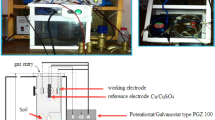Abstract
Slow strain rate stress corrosion tests on a 0.032 pct As brass in SO2 solutions of increasing dilution eventually resulted in tests being carried out in various waters which were also found to promote cracking. A 0.002 pet As brass was also found to be susceptible to cracking in deionized water, but in brackish water or an acidified sulfate solution this brass did not display the stress corrosion cracking observed in these more aggressive solutions by the higher As brass. The addition of arsenite to distilled water or arsenate to deionized water in sufficient amounts effectively inhibited the cracking observed at controlled potentials or open circuit in these waters without the As additions. The results are interpreted as indicative of dezincification being involved in these various environments that promoted cracking, but the extent of the dezincification plays an important role in determining whether or not cracking occurs, those additions leading to rapid and massive dezincification involving redeposition of dissolved Cu not being conducive to cracking.
Similar content being viewed by others
References
R.N. Parkins and N.J.H. Holroyd:Corrosion, 1982, vol. 38, p. 245.
H.W. Pickering and P. J. Byrne:Corrosion, 1973, vol. 8, p. 325.
L. Graf:Proc. of Conference on Fundamental Aspects of Stress Corrosion Cracking, The Ohio State University, Columbus, OH, NACE, 1969, p. 187.
R.G. Johnston:Sheet Metal Ind., 1940, vol. 14, p. 1197.
A.V. Bobylev:Intercrystalline Corrosion and Corrosion of Metals under Stress, I. A. Levin, ed., published by Leonard Hill (Books Ltd), London, 1963, p. 298.
W. Lynes:Corrosion, 1965, vol. 21, p. 125.
H. Uhlig:Corrosion, 1977, vol. 33, p. 189.
R. N. Parkins:Stress Corrosion Cracking—The Slow Strain-Rate Technique, ASTM STP 665, 1979, p. 5.
M. J. Pryor and Kar-Khang Gian:Jnl. Electrochem. Soc., 1982, vol. 129, p. 2157.
J. A. Beavers and E. N. Pugh:Metall. Trans. A, 1980, vol. 11A, p. 809.
J.R. Duncan and D. J. Spedding:Corr. Sci., 1973, vol. 13, p. 881.
W. D. Robertson:Stress Corrosion Cracking and Embrittlement, W.D. Robertson, ed., Wiley, New York, NY, 1956, p. 32.
L. Graf:loc. cit, W.D. Robertson, ed., Wiley, New York, NY, 1956, p. 48.
C. Edeleanu and A.J. Forty:Phil. Mag., 1960, vol. 5, p. 1029.
F. Mazza and S. Torchio:Corros. Sci., 1983, vol. 23, p. 1053.
V.F. Lucey:Brit. Corr. Jnl., 1965, vol. 1, p. 9 and 53.
H.W. Pickering and P.J. Byrne:Jnl. Electrochem. Soc., 1969, vol. 116, p. 1492.
R. H. Heidersbach, Jr. and E. D. Verink, Jr.:Metall. Trans., 1972, vol. 28, p. 397.
C. J. Smithells:Metals Reference Book, 3rd ed., Butterworths, Washington, DC, 1962, p. 383 ff.
A. P. Pchelnikov, A. D. Sitnikov, I. K. Marshakov, and V. V. Losev:Electrochimica Acta, 1981, vol. 26, p. 591.
Arvind Parthasarathi and Ned W. Polan:Metall. Trans. A, 1982, vol. 13A, p. 2027.
Henry Leidheiser, J. R. and Roy Kissinger:Corrosion, 1972, vol. 28, p. 218.
T. R. Pinchback, S.R. Clough, and L. A. Heldt:Metall. Trans. A, 1975, vol. 6A, p. 1479.
G. T. Burstein and R. C. Newman:Corrosion, 1980, vol. 36, p. 225.
Ned W. Polan, James M. Popplewell, and Michael J. Pryor:J. Electrochem. Soc., 1979, vol. 126, p. 1299.
G. D. Bengough and R. May:J. Inst. Met., 1924, vol. 32, p. 81.
A Paskin, A. Sieradski, D. K. Som, and G. J. Dienes:Acta Metall., 1983, vol. 31, p. 1253.
Rudolf Speiser and J.W. Spretnak;Stress Corrosion Cracking and Embrittlement, William D. Robertson, ed., John Wiley and Sons Inc., New York, NY, 1956, p. 92.
S.S. Birley and D. Tromans:Metall. Trans. A, 1981, vol. 12A, p. 1215.
D. Hardie: Department of Metallurgy and Engineering Materials, University of Newcastle upon Tyne, Newcastle upon Tyne, NE1 7RU, England, 1985, private communication.
Author information
Authors and Affiliations
Rights and permissions
About this article
Cite this article
Parkins, R.N., Rangel, C.M. & Yu, J. Stress corrosion cracking of α-brass in waters with and without additions. Metall Trans A 16, 1671–1681 (1985). https://doi.org/10.1007/BF02663023
Received:
Issue Date:
DOI: https://doi.org/10.1007/BF02663023




